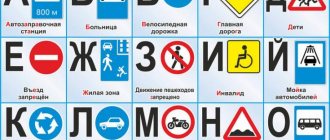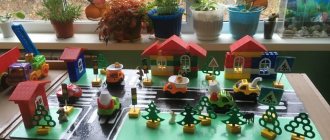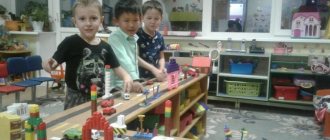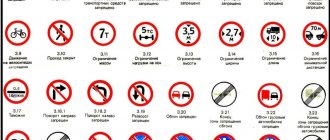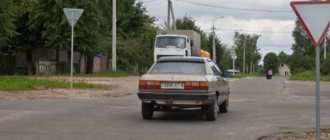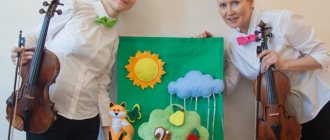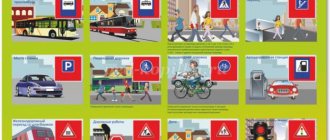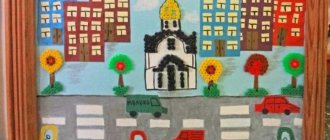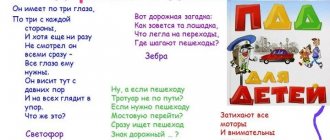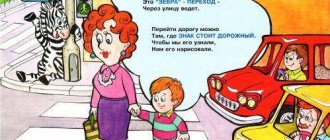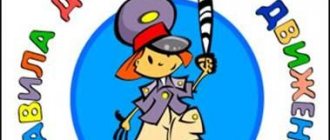Interactive layout for studying traffic rules “Road Traps”
Yulia Sokolova
Interactive layout for studying traffic rules “Road Traps”
Author: Yulia Viktorovna Sokolova - teacher - 1st category.
Interactive layout for studying the Rules of the Road “Road Traps”
Author:
Sokolova Yulia Viktorovna – teacher – 1st category.
1. Educational: to form the habit of always following traffic rules and the skill of observing traffic situations.
2. Educational: encourage compliance with traffic rules as a manifestation of culture.
Tasks:
•give children an understanding of the need to comply with traffic rules;
•exercise the ability to assess the traffic situation and make the right decision;
•educate competent pedestrians and take responsibility for their actions on the road.
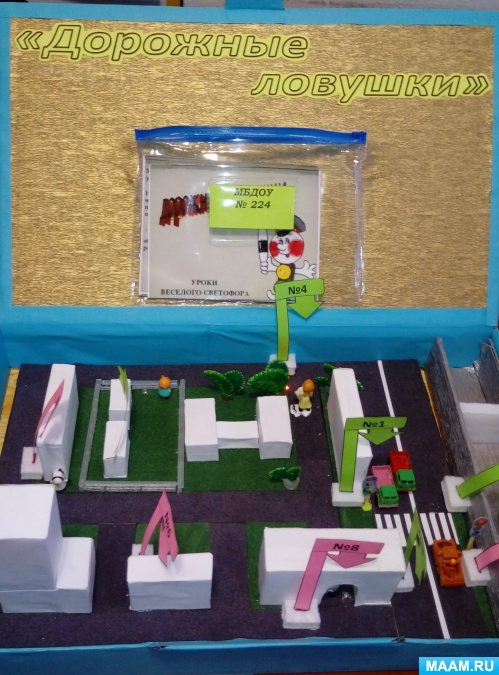
The layout can be used in joint activities of adults and children, group and subgroup, taking into account the integration of educational areas, as well as in individual work. Can be used for children's independent activities.
The interactive layout for studying traffic rules “Road Traps” can be used as a visual teaching aid.
It is possible to increase the number and variety of situations of road “traps” in the layout. It is possible to describe situations in poetry and in the form of riddles.
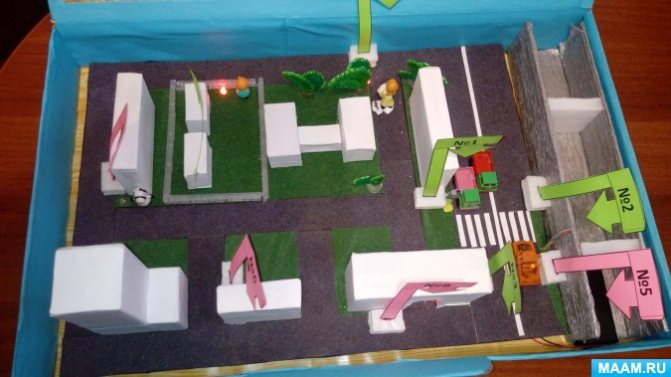
An interactive model for studying traffic rules “Road Traps” is made of various materials and consists of:
• box
• the main layout, on which, on a certain scale, a fragment of a microdistrict is made, consisting of: the building and territory of the MBDOU, as well as the nearest buildings, a pedestrian crossing, a roadway, streets, and inter-yard driveways.
• on the model, “road traps” are indicated by LED lights, which, when the toggle switch is turned on, begin to blink red.
• cards with “road traps”
• arrow signs are numbered according to the cards.
• figures of people and cars to simulate game situations of “road traps”.
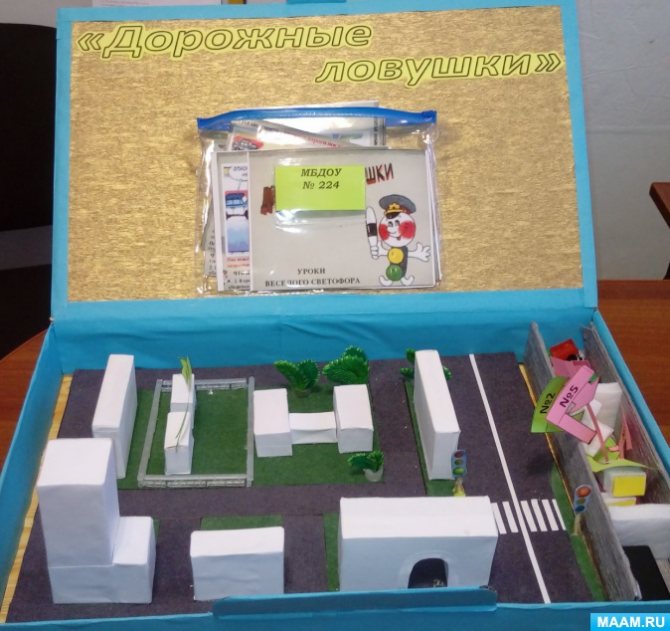
Description of working with the layout:
In joint activities of the teacher and children, group and subgroup, children can choose for themselves signs with arrows. The queue for studying and modeling the situation described in the card is determined by the serial number of the road “trap”, corresponding to the number on the sign.
The teacher reads out a card with a road “Trap”. Children discuss what can be done to avoid danger and suggest ways to solve the situation. And then, using figures of people and cars, they simulate a situation with a road “trap”.
Upon completion of consideration and modeling of road “Traps” on the layout, including the toggle switch, each situation on the layout is illuminated with a red blinking LED light.
Many people believe that accidents on the roads are an accident and it is impossible to protect yourself from them.
This is not true!
Accidents on the roads are an apparent accident.
Not many people know that 95% of children injured on the roads in traffic accidents were hit by cars in repeated situations, the so-called traffic “trap”.
Road traps are situations that contain hidden danger.
(The teacher needs to carry out explanatory work on each of the situations and select illustrations.)
Trap No. 1 “Stationary car”
A stationary car can block another car that is moving at high speed, making it difficult to notice the danger in time.
What to do?
1. You cannot go out onto the road because of standing cars.
2. As a last resort, you need to carefully look out from behind a standing car and make sure that there is no danger and only then cross the road.
Trap #2 “Slow moving car!”
It can hide behind a car traveling at higher speeds.
Pedestrians are often unaware that behind one car there may be another hidden.
What to do?
The car is approaching slowly, but you still have to let it pass.
Trap No. 3 “Crossing the road after getting out of a vehicle”
A stationary bus hides a section of the road along which a car may be passing at the moment when you decide to cross it.
What to do?
Do not go around a stationary bus, either in front or behind!
From the stop you need to move towards the nearest crossing.
Trap No. 4 “Objects blocking the road!”
Because of a stationary car, a house, a bush fence, a turn, a snowdrift, etc., a car may unexpectedly drive out.
What to do?
1. To cross the road, you need to choose a place where the road is visible in both directions
2. As a last resort, you can carefully look out because of the obstacle to make sure that there is no danger and only then cross the road
Trap No. 5 “crossing the roadway when the light is green!”
Today on city roads we are constantly faced with car drivers violating traffic rules: driving at high speed, ignoring the green traffic light and crossing signs.
What to do?
It is necessary to make sure that there is no danger - the transport is stopped, drivers allow pedestrians to pass.
Trap No. 6 “Deserted streets!”
On a street where cars rarely appear, children run out onto the road without first checking it and get hit by a car.
What to do?
Develop the habit of always stopping before going out onto the road, looking around, listening - and only then crossing the road.
Trap No. 7 “Being on the roadway!”
Having reached the center line and stopped, pedestrians usually only watch for cars moving on the right side and forget about the cars passing behind them. Frightened, a pedestrian can take a step back - right under the wheels of a car.
What to do?
If you had to stop in the middle of the road, you must be extremely careful and not make a single move without making sure it is safe. When standing on the center line, remember: there may be a car behind you!
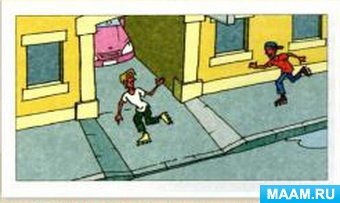
Trap No. 8 “Arches and exits from courtyards!”
In large cities, places of increased danger are arches through which cars drive out of courtyards onto the roadway.
What to do?
1. Stop at the arch and make sure there are no cars by looking behind it.
2. Do not allow a small child to run past the arch in front of an adult; he must be held by the hand.
On the street, hold an adult's hand tightly!
Being with adults nearby, children rely on them and either do not watch the road at all or watch poorly. On the street, children are distracted by all sorts of objects and sounds, not noticing a moving car, and thinking that the way is clear, they break away from the hands of an adult and run across the road.
What to do?
When crossing the road, adults should hold the child's hand tightly.
Information sources
https://labstend.ru/site/index/folies/school/pdd/p0020.gif
https://labstend.ru/site/index/folies/school/pdd/p0021.gif
https://zholpolice.kz/ru/childtrauma/danger/
https://obr-resurs.ru/obr_res/bjd/plakatPDDdou08.doc
https://www.szkv97.ru https://reklamatalmenka.my1.ru/load/8-1-0-18
Layout for learning traffic rules in kindergarten for children of the second junior group
Nadiya Sarmolaeva
Layout for learning traffic rules in kindergarten for children of the second junior group
Topic: Layout for studying traffic rules in kindergarten for children of the second junior group.
The layout is intended both for direct educational activities of children and for independent activities.
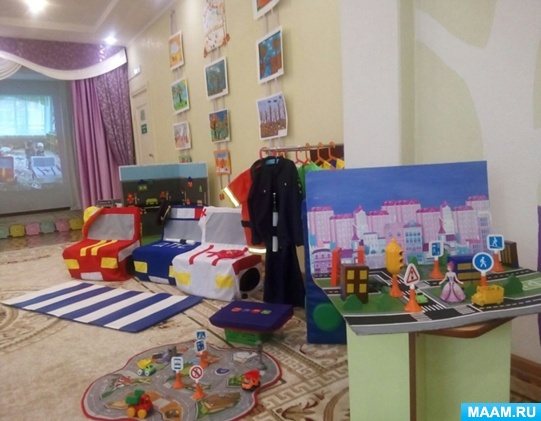
Target:
Modeling and developing the foundations of safe behavior on the road; prevention of children's road traffic injuries.
Tasks:
— introduce children to traffic rules, purpose, signals and colors of traffic lights, road signs, expand and deepen knowledge about the rules of behavior for children on the street;
— give children the opportunity to independently use the traffic rules corner.
List of materials used to create the layout: small fiberboard sheet, PF-115 enamel paints, Lego sets, boxes of various shapes, road signs.
Description of the manufacturing progress when creating the layout. For the layout, we used a small piece of fiberboard (we measured the size of the surface of the bedside table where the layout will stand). The road, sidewalk, pedestrian crossings, and buildings were painted on fiberboard using paints of different colors. We used LEGO constructors (trees). Road signs. Children can play with small toy cars, observing traffic rules and placing signs. You can independently simulate situations on the roadway and play them out. While studying on the model, children simulate various situations to improve the norms of behavior on the street, on the roadway.
Description of the games that are played with its help.
Game "Street"
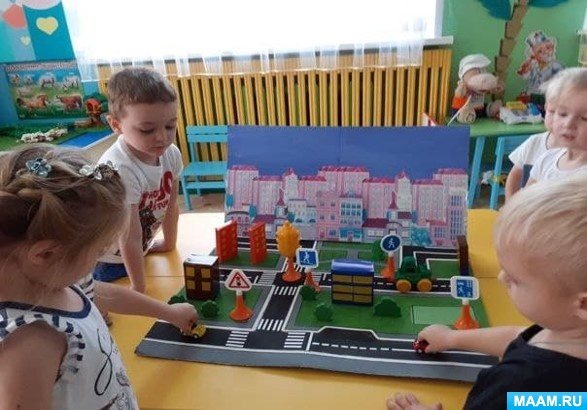
Tasks:
1. Enrich children’s knowledge about the rules of pedestrian behavior on the street.
2. Improve children’s understanding of traffic lights
3. Teach children to distinguish road signs.
Material: model of a street with houses, a crossroads, cars (toys, kinder figures - pedestrians, road signs, trees (models).
The game is played on a layout. Progress of the game.
With the help of figures, children role-play various road situations. At a controlled intersection, when the traffic light is green, they cross the street, when the traffic light is yellow, they stop and wait, and when the traffic light is red, they continue to stand. Then the figures walk along the sidewalk to a pedestrian crossing, indicated by the information sign “Pedestrian Crossing,” and cross the roadway.
Game "City Street"
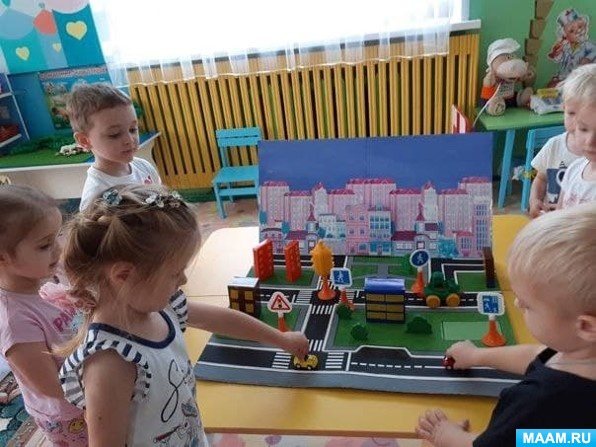
Tasks:
Clarify and consolidate children's knowledge about the rules of behavior on the street, traffic rules, and various types of transport. Material: street layout, trees, cars, kinder figures - pedestrians, traffic lights, road signs. Progress of the game.
The teacher examines the street layout with the children and asks questions. Children accompany their answers by showing them on a model. Questions for children:
What houses on our street do you know?
What kind of traffic on our street is one-way or two-way?
Where should pedestrians walk? Where should cars go?
What is a crossroads? Where and how should it be crossed?
What road sign indicates a pedestrian crossing?
How is traffic regulated on the street?
What colors does the traffic light use?
What road signs are on our street? What are they needed for?
What type of transport is used to transport more people? Where do people wait for passenger transport?
What rules of behavior do people use on the bus?
Is it possible to play outside? What could be the consequences of playing in the wrong place?
Next, the teacher invites the children to play with the model, using figurine toys, and drive along the street, observing the traffic rules. Then one of the children plays the role of a pedestrian. The winner is the one who copes better with the roles of driver and pedestrian.
